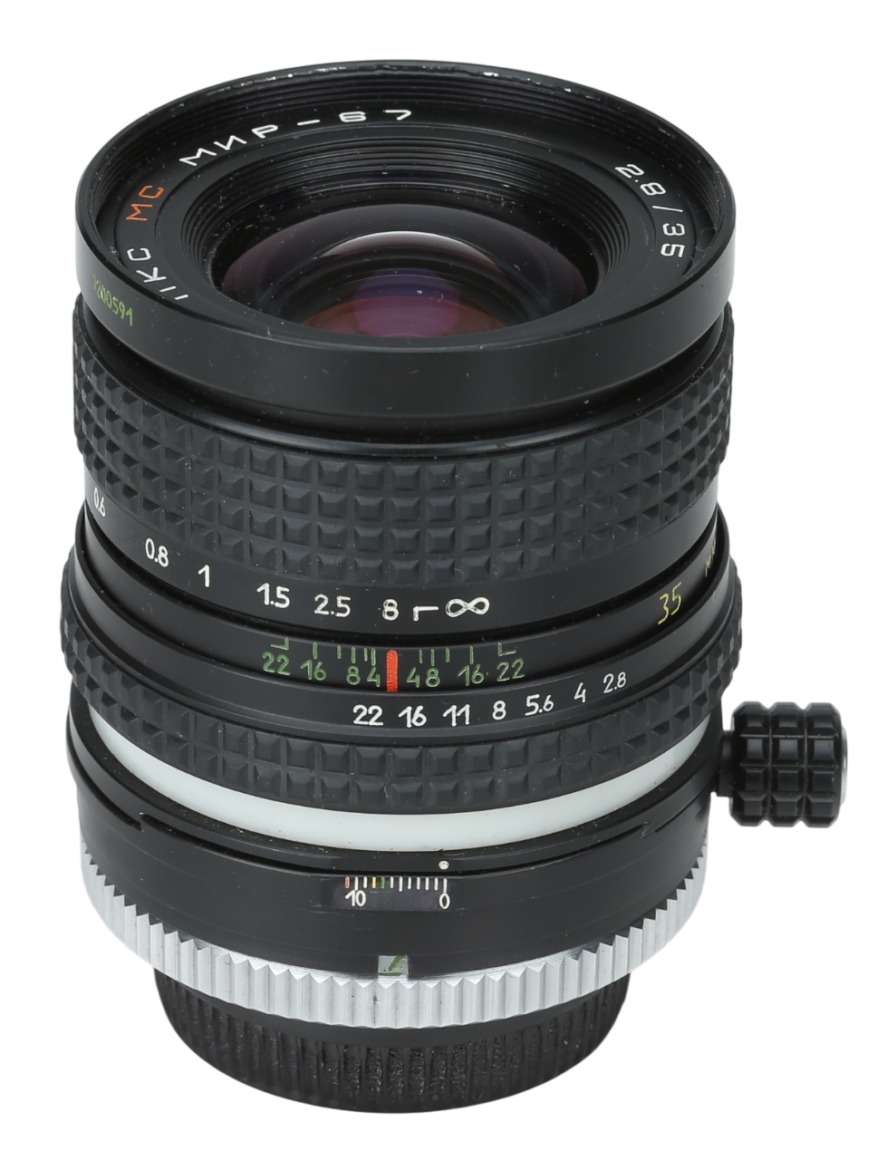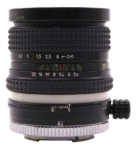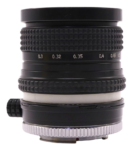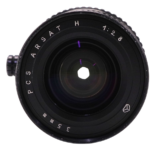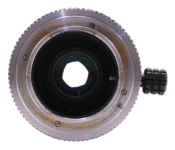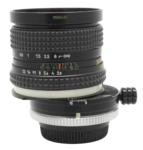Mir-67N 35mm F/2.8 PCS MC
akaArsat H 35mm F/2.8 PCS
akaМИР-67Н 35mm F/2.8 ПКС МС
Shift lens • Film era • Discontinued • Collectible
- Announced:
- · 1990
- Production type:
- · Small-batch production
- Availability:
- ● Sold out
- Country of design:
- · USSR (Union of Soviet Socialist Republics)
- Original name:
- · ПКС МС МИР-67 2.8/35
- · PCS ARSAT H 1:2.8 35mm
- Class:
- · Fast full-frame shift lens
- · Professional model (Top class)
- System:
- · Kiev-17/19/20 (1978)
Abbreviations
| MC | Multi-layer anti-reflection coating is applied to the surfaces of lens elements. This anti-reflection coating increases light transmission, eliminates flare and ghosting, and maintains color consistence among all lens models. |
Specification
| Optical design: | |
| 35mm full frame | |
| 35mm | |
| F/2.8 | |
| 11 elements in 8 groups | |
| Nikon F [46.5mm] | |
| 63.4° (35mm full frame) | |
| On Nikon D APS-C [1.53x] cameras: | |
35mm equivalent focal length: | 53.6mm (in terms of field of view) |
35mm equivalent speed: | F/4.3 (in terms of depth of field) |
Diagonal angle of view: | 44° |
| Diaphragm mechanism: | |
Diaphragm type: | Preset |
Aperture control: | Aperture ring |
| 6 (six) | |
| Focusing: | |
| 0.30m | |
| <No data> | |
Focusing modes: | Manual focus only |
Manual focus control: | Focusing ring |
| Perspective control mechanism: | |
Shift range: | 0..+11mm |
Tilt range: | Not available |
| Yes | |
| - | |
| Physical characteristics: | |
| 500g | |
| ⌀73×79mm | |
| Accessories: | |
| Screw-type 62mm | |
| <No data> | |
| <No data> |
Source of data
- Manufacturer's technical data.
Manufacturer description
The ПКС МС МИР-67 Н is an eleven-element wide-angle photographic lens with an optical axis shift (PCS - perspective correction by shift). The wide angle of view, significant depth of field, the ability to shift the optical axis allow the lens to be used for shooting from short distances, in technical and scientific photography, to correct perspective distortions when photographing architectural ensembles and when shooting still life. It is intended as an interchangeable lens for the КИЕВ-19 and КИЕВ-19М cameras.
From the ФОТОГРАФИЯ magazine (ex СОВЕТСКОЕ ФОТО) (May-June 1995)
Old bulky heavy cameras with bellows and modern studio cameras have a significant advantage over a regular small-format camera - the ability to shift, tilt, rotate the objective front, and sometimes the rear cassette board. Such a device allows you to solve various problems when shooting, guarantees high image quality, control of the depth of field, shape (correction of vertical lines) and position of the image on the photographic material.
A small-format camera lacks the above-mentioned movements, which significantly limits the photographer's work. An attempt to at least partially solve this problem was the release a couple of decades ago of lenses with a shift or tilt of the optical axis (shift-tilt optics). These lenses are convenient in architectural photography to correct "falling verticals" when the camera is tilted strongly upward. When shooting, the focal plane of the camera is positioned parallel to the vertical building, and the lens is shifted upward. In creative photography, by manipulating the tilt of the camera and the shift of the lens, you can achieve various pictorial effects.
These optics are wide-angle lenses with an image field larger than necessary to cover a 24x36 mm frame. Thus, in a lens with a focal length of 35 mm, the useful angle of a high-quality image is about 80° instead of the usual 63°. The optical system of the lens can be shifted (up to 12 mm) relative to the parts of the mounting frame in a plane perpendicular to the optical axis. This is done using a dovetail guide, a micrometer screw and a special scale with a division value of 1 mm.
Shift lenses can be used when shooting large glass surfaces (photographing paintings in a museum). They are also useful in cases where an object (a branch, a pole) gets into the frame and interferes with shooting. Shift optics significantly expand the visual capabilities of an experienced photographer.
The ПКС Мир-67Н lens, developed in 1990 at the Arsenal plant (Kiev), became the first serial lens with an optical axis shift.
Resolving power, mm-1:
when focusing at infinity: center of the field: 45, edges of the field: 30, when shifted (y-1=26mm): 27;
when focusing at 0.3m: center of the field: 43, edges of the field: 7.
y1 is the distance from the center of the frame to the point of interest in the image.
Color formula: -15-0-0 with an acceptable deviation of +/- 3 at the extreme values. Light transmission is not less than 0.8. Light scattering coefficient is not more than 0.015. Illumination at the edge of the image field relative to the center at F/2.8: not less than 35%, when shifting the optical axis: 18%.
The ПКС МС Мир-67Н lens, renamed in 1993 to ПКС Арсат Н 2.8/35 (derived from the word Арсенал), in its usual version has an "Н"-type bayonet mount and is designed for the small-format single-lens reflex camera Kiev-19. Versions of the lens were developed for Zenit cameras (with an M42X1 screw mount and a K bayonet mount).
The lens provides for the displacement of the optical block perpendicular to the optical axis up to 11+0.5 mm and its rotation around the bayonet axis by 360° with a lock every 30°. Since the frame format in the camera is rectangular, the displacement of the optical block is not constant and changes for each rotation angle. The maximum displacement, at which vignetting is excluded, is determined by a special scale. The design allows any displacement of the optical axis of the lens relative to the center of the frame.
The designation of Ukrainian lenses includes the abbreviation ПКС, composed of the first letters of the words "perspective, control, shift".
From the editor
The lens was produced by the Arsenal Plant (Kiev, USSR) in the early 1990s in small batches. After the collapse of the Soviet Union, the lens was sold under the name "PCS ARSAT H 1:2.8 35mm".
The lens has a manually controlled aperture with stepless travel and presetting. To limit the travel of the ring, you need to turn it to the position of the maximum closed aperture, pull it back, move it to the desired aperture value and release. The spring will move the ring forward, and the preset aperture will be fixed.
The shift mechanism only moves in one direction, but the lens barrel can be rotated around its axis in 30-degree increments.
Lenses with similar focal length
| ■Nikon F mount (7) | |||||||||
| Nikon PC-Nikkor 35mm F/2.8 | P | 7 - 7 | 0.30m | ⌀52 | 1980 ● | ||||
| Nippon Kogaku PC-Nikkor 35mm F/3.5 | P | 6 - 6 | 0.30m | ⌀52 | 1962 ● | ||||
| Nippon Kogaku / Nikon PC-Nikkor 35mm F/2.8 | P | 8 - 7 | 0.30m | ⌀52 | 1968 ● | ||||
| Nikon PC-Nikkor 35mm F/2.8 | P | 8 - 7 | 0.30m | ⌀52 | 1975 ● | ||||
| Arax 35mm F/2.8 S&T | P | 11 - 8 | 0.30m | ⌀62 | ● | ||||
| Hartblei Super-Rotator 35mm F/2.8 TS-PC MC | M | 11 - 8 | 0.20m | ⌀82 | ● | ||||
| Hartblei Zeiss Super-Rotator 40mm F/4 IF TS | M | 12 - 9 | 0.50m | E86 | 2008 ● | ||||
| ■Interchangeable mount (2) | |||||||||
| Schneider-Kreuznach PC-Curtagon 35mm F/4 MC | M | 7 - 6 | 0.30m | ⌀49 | ● | ||||
| Schneider-Kreuznach PA-Curtagon 35mm F/4 | M | 7 - 6 | 0.30m | ⌀49 | 1967 ● | ||||
